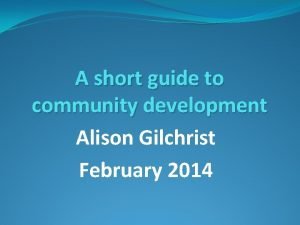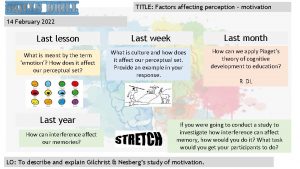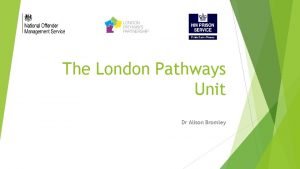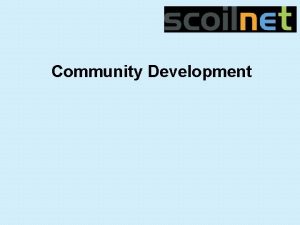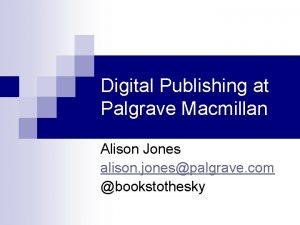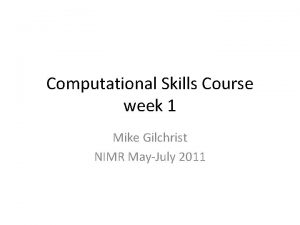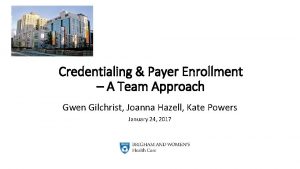A short guide to community development Alison Gilchrist












- Slides: 12

A short guide to community development Alison Gilchrist February 2014

Introduction and overview �My background and journey �Short Guide to CD as basis for my input �Definitions and terms �Development of ‘what’? �History and models of CD �Practice – principles and processes �Current debates and dilemmas �Future challenges �Conclude with time for questions and discussion

Definitions and terms �CD as working with, not for, communities to achieve improvements and address shared issues �Problems, priorities and solutions determined by communities themselves �Emphasis on shared concerns and collective strategies �Values-based – social justice, inclusion and equality, human rights (small ‘p’ politics)

Brief history Several roots �Philanthropy �Participation �Partnership �Pedagogy �Politics Three broad models �Changing the system - radical �Influencing the system - pluralist �Making the system work better – consensus

CD as development of ‘community’ Self-help, organising for influence and action Sense of belonging and solidarity �Efficacy �Capacity �Resilience �Social capital �Active citizenship �Community engagement �Shared identity �Cohesion �Well-being �Mutual care and respect �Volunteering �Community pride/spirit

Processes and practice: 7 E’s all focused on interests of others rather than ‘self’ �Enabling �Empowering �Encouraging �Educating �Equalising �Engaging �Evaluating

Various models �Community organising/action �Neighbourhood development �Capacity building �Informal education �Community engagement/active citizenship �Social investment/community enterprise �Critical community practice �User empowerment/co-production �Asset-based community development �Participatory action research �Networking approaches

Debates and dilemmas Specialist occupation, approach or movement? �‘Deficits’ versus ‘strengths’ analysis �Power dimensions – local -> global levels �Social justice – various understandings �Organic emergence or external intervention �Role awareness/boundaries/responsibilities �Orientation/accountabilities

Current and future challenges Employment situation and status � Invisible/precarious/contested job � National occupational standards � Maverick individuals � Management difficulties � Demonstrating impact/measuring value � Policy-driven, short term � Not community-led and longterm � Funding and recognition of professional role Changing society and technology �Re-configuring ‘community’ � geography, interest and identity � Intersectional identities � Increasing diversity and more mobile communities �Rising inequalities and poverty �Everyday Internet usage � Social media, on-line networking � Digital disadvantage

Some concluding thoughts �Policy shifts in recent decades �Partnership – contracts, user involvement, V+CS commissioning �Community engagement/empowerment �Localism – planning, community-run services �Big Society – self-help, volunteering �Paradox – best CD is invisible, so constantly needs rediscovering by successive governments and generations �Potential – massive and enduring

Resources and reading �Gilchrist and Taylor (2011) Short guide to community development �Craig et al (2011) CD in the UK – a reader �Ledwith (2005) Community development – a critical approach �www. iacdglobal. org �www. fcdl. org. uk �www. cdf. org. uk

Questions for reflection and discussion �Would you say you using a CD approach in your work or your life? �Thinking about your own experience, do you recognise the opportunities and issues I have raised? �What’s been useful and what’s missing?
 Tall + short h
Tall + short h Alison gilchrist
Alison gilchrist Gilchrist and nesburg study of motivation
Gilchrist and nesburg study of motivation Alternative passion
Alternative passion Trevor gilchrist
Trevor gilchrist Explain community development
Explain community development Study guide chapter 3 section 1 community ecology
Study guide chapter 3 section 1 community ecology Morton heilig biography
Morton heilig biography Alison voice leeds
Alison voice leeds Alison bromley
Alison bromley Vertical angles
Vertical angles Real life superheroes book by alison
Real life superheroes book by alison Alison crane
Alison crane

